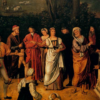On Earth as It Is in Heaven: A Biblical Theology of Worship
WORSHIP AT THE DAWN OF TIME
Since the beginning of time, there has been worship—in heaven and on earth. In heaven above, seraphim flew before God in the heavens, singing, “Holy, holy, holy is the Lord God of hosts; the whole earth is full of his glory!” (Isa. 6:3); angelic creatures flew before him, calling to one another, “Holy, holy, holy, is the Lord God Almighty, who was and is and is to come!” (Rev. 4:8) On earth below, the sun, moon, and stars sounded forth his praise across every land and sea under the heavens: “Praise him, sun and moon, praise him, all you shining stars” (Ps. 148:3).
WORSHIP IN EDEN
In the beginning, God also called Adam to covenant worship on Mount Eden (cf. Ezek. 28:14) through his word and sacrament: “And the Lord God commanded the man, saying, ‘You may surely eat of every tree of the garden, but of the tree of the knowledge of good and evil you shall not eat, for in the day that you eat of it you shall surely die’” (Gen. 2:16–17). Adam was commanded to fast from one tree in order that he might feast at another tree, and thus enjoy consummate union and communion with God—everlasting life. And so for Adam and all his descendants, a liturgy was fixed, stitched into the very order and fabric of human life on earth: call—response—meal:
- Call to worship (through God’s Word and sacrament)
- Response (by faith and obedience)
- Fellowship meal (union and communion with God)
In short, God established worship on Mount Eden with his son, Adam. It was familial, covenantal worship of God through word and sacrament—the word of the covenant of life and the sacrament of the tree of life.
IDOLATRY IN EDEN
But Adam’s worship soon turned to idolatry when he abandoned the call of God and followed the call of the serpent. He abandoned his probationary fast, disobeyed the voice of his God, and bowed down to the serpent. He exchanged the worship of the Creator for the worship of the creature. Since Adam was the covenant head of humanity, he introduced the liturgy of idolatry into the fabric of human life.
WORSHIP THROUGH SACRIFICE
Yet God is too great and good and glorious to forego the right, fitting, and delightful adoration that is due him from his creatures. God worked to restore the worship of himself by making a new covenant with man—the covenant of grace.
In Genesis 3:15, the promise of a son who would come and crush the serpent was, by implication, a promise to restore—and perfect—the worship of God. This covenant of grace became the context in which God would restore worship. Integral to that restored worship was the idea of sacrifice—seen in the animal skins that God provided for Adam and Eve (Gen. 3:20).
As redemptive history unfolds, sacrifices play an important part in the lives of the chosen seed. Noah, Abraham, Isaac, and Jacob respond to God’s call in faith and obedience; they offer sacrifices to God. Sacrifice also becomes central to the life of Israel, God’s national (typical) son. The purpose of the exodus is described in terms of worship by sacrifice at Mount Sinai (Exod. 3:12, 18; 4:23; 5:2; 10:7–11).
Worship by sacrifice in the Holy of Holies reaches its climax under King Solomon, God’s royal (typical) son. In his “dedication service” for the temple on Mount Zion, Solomon offers so many sheep and oxen that they could not even be numbered (2 Chron. 5:6). In the covenant of grace, worship by sacrifice in God’s presence becomes the new norm.
WORSHIP AT EDEN, SINAI, AND ZION
The Old Testament story presents three “mountain peaks” of worship in which God’s son is called to worship: Adam on Mount Eden, Israel at Mount Sinai, and Solomon on Mount Zion. In each worship setting, the liturgical order is organically developed. For example, as Israel gathers at Mount Sinai, after being redeemed and rescued out of slavery in Egypt, a liturgy is formed that becomes the basic pattern for Israel’s worship in the future.
- Gathering (at Mount Sinai) (19:1–3a)
- Calling (by God’s word) (19:3b–9)
- Cleansing (through sacrifice) (19:10–15)
- Mediated access (through an appointed prophet-priest) (19:16–25)
- Divine communication (Ten Commandments and Book of Covenant) (20:1–24:2)
- Consecration (promise of obedience) (24:3)
- Sacrifice (burnt offerings and peace offerings) (24:4–5)
- Divine communication (Book of Covenant) (24:7)
- Cleansing (blood of burnt offerings and peace offerings sprinkled) (24:6, 8)
- Mediated access to God’s presence (24:9–10)
- Fellowship meal (with God) (24:11)
A similar pattern to Exodus 19–24 is seen in 2 Chronicles 5–7, as Solomon gathers Israel for the dedication of the temple. Again, the key elements of sacrifice and prophetic-priestly intercession are present:
- Gathering (at Mount Zion) (5:2–3)
- Cleansing (through sacrifice) (5:4–6)
- Mediated access (through priests) (5:7–10)
- Praise (with singing and music) (5:11–13)
- Glory of God fills the temple (5:14)
- Divine communication (Word of God through Solomon) (6:1–11)
- Prayer of intercession (by Solomon) 6:12–42)
- Fire and glory (from heaven) (7:1–2)
- Praise (bowing and thanking) (7:3)
- Cleansing/consecration (through sacrifice) (7:4–7)
- Meal (feast) (7:8–10)
- Blessing and dismissal (7:9–10)
In sum, this is how the Old Testament “worship service” develops—first with God’s national (typical) son Israel at Mount Sinai, and then with God’s royal (typical) son Solomon at Mount Zion. Notice how the general structure of worship with God’s (first) son Adam on Mount Eden remains: call—response—meal. However, because of sin, new essential elements are incorporated into the worship of God’s redeemed people within the covenant of grace: gathering, cleansing, mediated access, divine communication, and cleansing/consecration.
ADAM, ISRAEL, AND SOLOMON—IDOLATROUS SONS
The worship that began and failed with Adam is restored with Israel and Solomon, at least partially. Though imperfect, Israel and Solomon’s worship is acceptable to God because it’s their response within a gracious arrangement—the covenant of grace. Yet the worship of God, as originally intended in Eden, and progressively restored by Israel and Solomon, is never perfected or fully realized.
For example, at Sinai, Israel exchanges the worship of God (the Creator-Redeemer) for the worship of the golden calf (a creature-redeemer); and at Peor, Israel is led into idolatry by (foreign) women. Under Solomon, the pure worship of God begins to emerge in the early period of a united Israel. The worship that was revealed in Eden and developed at Sinai begins to be realized on Mount Zion with Solomon’s “dedication service” of the temple. And yet, it’s not long before the worship of God on Zion is corrupted by Solomon himself. Despite God’s gracious gift of wisdom, Solomon is led into the foolishness of idolatry through the influence of his (foreign) wives.
IRREVERSIBLE IDOLATRY
Because of Solomon’s idolatry, not only does the kingdom split, but the divided nations of Israel and Judah eventually spiral into an ever-deepening, and irreversible idolatry—one which thrusts them both into exile to the east (2 Kgs. 17:14–18; 24:20). Thus, the history of God’s national (typical) son Israel (united or divided) repeats Adam’s idolatry. As with Adam, Israel hears an alternative call to worship—a word of invitation from the Baals and Asherim—and responds in faith and obedience to creatures, not the Creator. Israel feasts at the altars and high places of other gods and not at the temple of the one true God.
Seventy years later, when Israel is relocated to the land and reaffirmed as God’s son—with a fully functioning temple on Mount Zion—it soon becomes clear that the exile didn’t change Israel’s heart. No sooner is Israel back in the land than they begin to desecrate the Sabbath, pollute the cult with blemished sacrifices, and commit idolatry through intermarriage to foreign women (Neh. 13; Mal. 1:6–14). The heart change that Ezekiel foretold in exile—in which God would give them a new heart, and put a new spirit in them, and cause them to walk in his ways (Ezek. 36:26–27)—has not yet occurred. That change requires God himself to come to his temple, to purify the sons of Levi, and to restore right worship in Zion: “Then the offering of Judah and Jerusalem will be pleasing to the Lord as in the days of old and as in former years” (Mal. 3:4).
PERFECTED WORSHIP
By the end of the Old Testament, we’re left hoping for a son of God who will worship God perfectly, and who will then lead his bride in pure worship of the one true God. That expectation is finally met in the coming of God’s final Son, Jesus Christ—the Last Adam, the true Israel, and great David’s greater son. The era of perfected worship begins to dawn when Jesus meets a Samaritan woman—a foreigner, interestingly—and informs her that his Father is seeking a people to worship him in spirit and in truth, not on Mount Gerissim nor on Mount Jerusalem below (John 4:21–24), but in Mount Zion above:
But you have come to Mount Zion and to the city of the living God, the heavenly Jerusalem, and to innumerable angels in festal gathering, and to the assembly of the firstborn who are enrolled in heaven, and to God, the judge of all, and to the spirits of the righteous made perfect, and to Jesus, the mediator of a new covenant, and to the sprinkled blood that speaks a better word than the blood of Abel. (Heb. 12:22–24)
* * * * *
Editor’s note: This is an adapted excerpt from Jonathan Gibson’s opening chapter “Worship: On Earth as It Is in Heaven,” in Reformation Worship: Liturgies from the Past for the Present (live link www.reformationworship.com).








